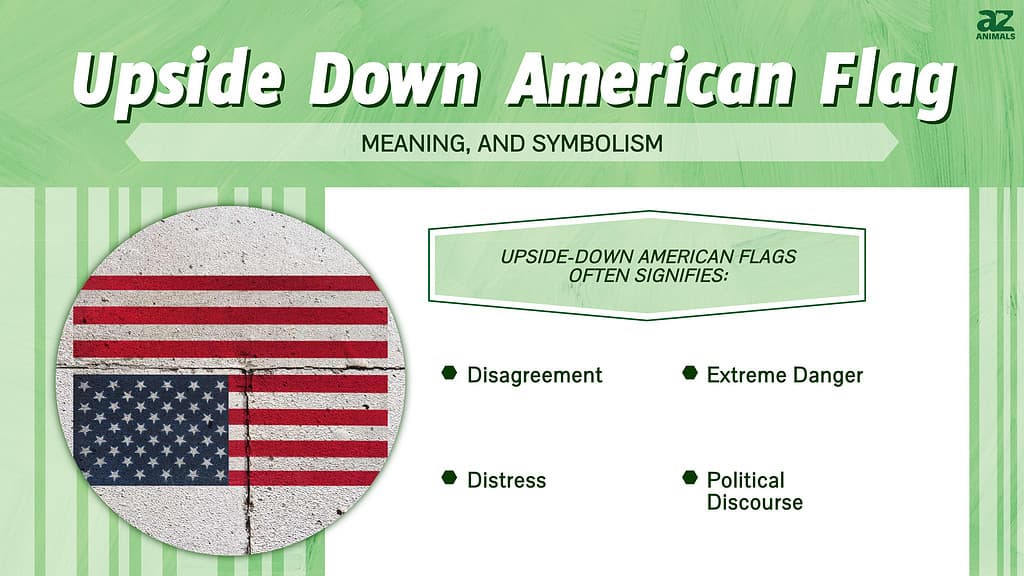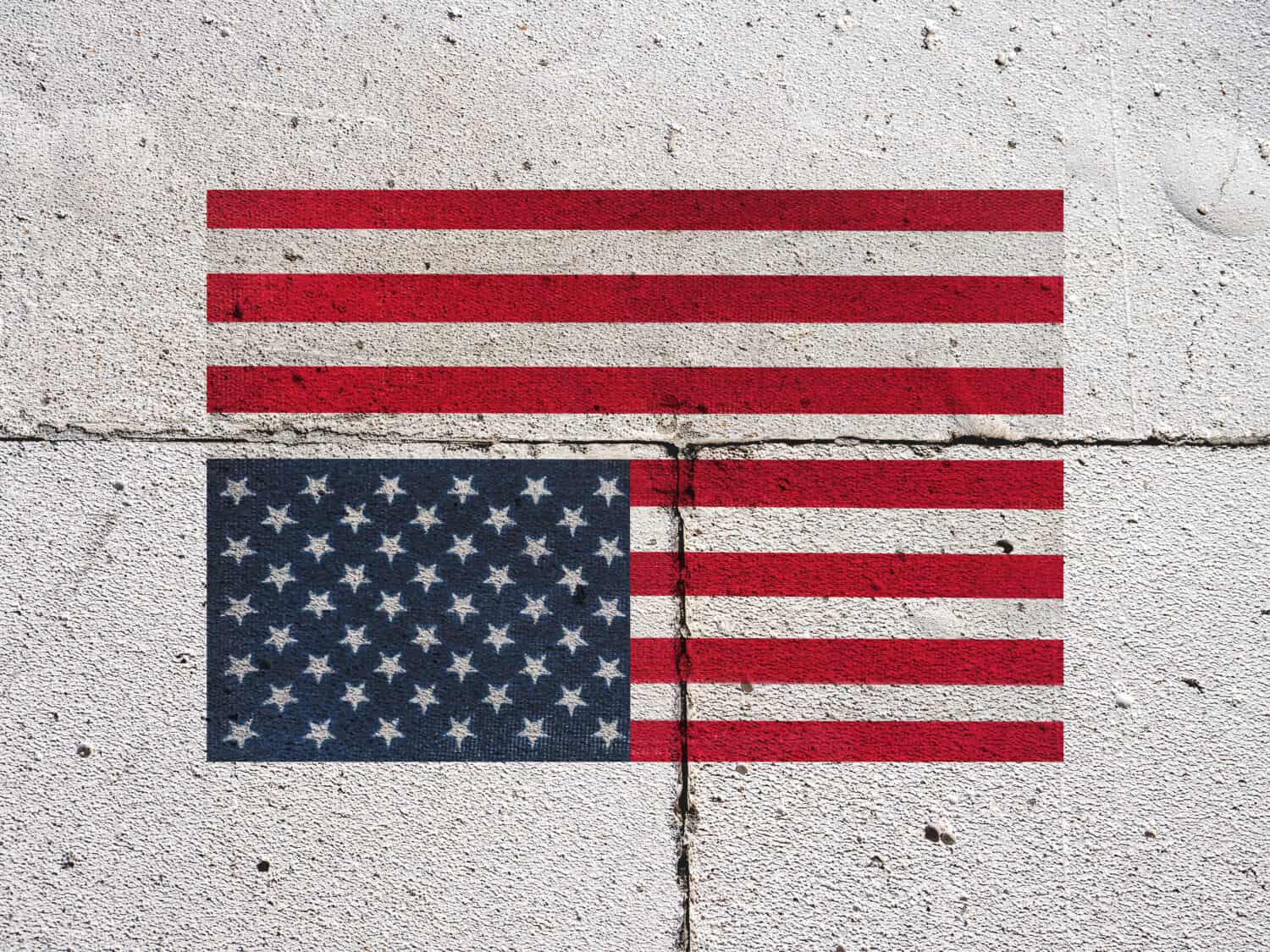What Does It Mean To Fly The U.S. Flag Upside Down?
What message is subtly yet powerfully conveyed when the American flag is flown upside down? The inverted American flag, a symbol steeped in history, serves primarily as a distress signal, a cry for help, or a potent expression of dissent.
The United States Flag Code, a comprehensive set of guidelines governing the display and appearance of the nation's banner, offers a stark pronouncement: the American flag should never be displayed with the union (the blue field with stars) down, save in situations of "dire distress in instances of extreme danger to life or property." This is the foundational context. Yet, despite the meticulous nature of these flag laws, it's essential to understand that flying the flag upside down is not, in and of itself, illegal. It is a recognized signal, a visual shorthand that transcends mere aesthetics and plunges into the realms of history, political expression, and societal anxieties.
| Aspect | Details | Additional Information |
|---|---|---|
| Historical Context | The inverted flag has maritime origins, symbolizing a vessel in dire straits, on the verge of sinking. The signal was immediately recognized by other ships in the area as a plea for help. This deeply ingrained association with distress forms the foundation of its contemporary use. | The practice is rooted in the International Code of Signals used at sea to communicate distress. |
| Modern Usage | Today, the upside-down flag transcends its purely nautical roots and is used as a form of protest or a symbol of national distress. It can signal various levels of societal dissatisfaction, from specific policy disagreements to broader concerns about the state of the nation. | Its interpretation is often subjective, based on the context in which it is displayed and the prevailing political climate. |
| Political Protest | The upside-down flag has become a powerful tool for political expression, employed by individuals and groups to voice their discontent with government policies, actions, or societal trends. | The practice became more visible recently with the election loss protest by Trump supporters and other partisan use of the symbol. |
| Legal and Ethical Considerations | While not illegal in itself, the display of an upside-down flag sparks heated debate. Some interpret it as a legitimate exercise of free speech, while others view it as disrespectful to the flag and the nation it represents. | The nuances of its meaning are subject to individual and collective interpretations, shaped by personal beliefs and cultural contexts. |
| Black Upside-Down Flag | The combination of a black color scheme with an inverted American flag can be a complex symbol, often related to mourning or specific political movements. | The black-and-inverted flag can also be used to express sorrow, loss, or solidarity. |
| Canada | Canada follows a similar protocol, with its flag rules stating the flag should only be inverted in instances of extreme danger to life. | The use of inverted flags transcends national boundaries and reflects universal concepts of danger or political dissent. |
| Historical Significance | The upside-down flag as a protest tool has been used for at least 50 years. | The Supreme Court even supported the use of the flag with an added peace symbol. |
| The Meaning of "Distress" | Displaying the flag in this manner indicates distress at a national level, suggesting that something is amiss. | Understanding its history, and recognizing its use, is important to understanding its interpretation. |
The implications of an inverted flag stretch far beyond a mere visual cue. Its a conversation starter, a lightning rod for diverse opinions, and an invitation to delve into the complex tapestry of American identity and societal unease. Those who choose to fly the flag upside down are making a statement, whether it's a subtle plea for assistance, a strong condemnation of current events, or a nod to a long-standing tradition of protest. But understanding its intent necessitates a closer look.
- Compliance Movie Nude Scenes Watch Free Explore Now
- Neverwinter Nights Romance Options Enhanced Edition Guide
The U.S. Flag Code, a compendium of guidelines established in the 1920s, provides the official context. The code explicitly outlines, in Title 4, that the flag should "never be displayed with the union down, except as a signal of dire distress in instances of extreme danger to life or property." This codified meaning is the bedrock of the symbol's interpretation. The code itself recognizes the urgency and severity associated with inverting the national banner.
However, it is important to differentiate the formal guidelines from the realities of its usage. While the Flag Code specifies the meaning, the application is often more nuanced. It is not technically illegal to fly the flag upside down. This is the critical distinction, as it helps explain the frequent employment of the gesture in expressions of protest.
Consider the perspective of the individual, the protester, the citizen whose flag is intentionally displayed upside down. They are invoking the historical association of distress. Their actions are a declaration. The upside-down flag, in this context, can become a visual expression of national malaise. It is a statement of belief that things are not well, a plea for change, a warning, or sometimes a lament.
- Catriona Gray Sam Milby Relationship Timeline Updates
- Adult Content Search What To Know Before You Browse
The usage of this symbol has gained new visibility in recent years. The symbol has been seen with groups protesting, reflecting the depth of feelings about political and social issues. The visual can sometimes be misinterpreted because its meaning is not universally understood.
Its a historical symbol, and there are maritime origins that can be traced back to the International Code of Signals used at sea. Ships in distress would fly the flag upside down to signal that they were sinking or in need of immediate assistance. This historic connection is still relevant.
The use of the upside-down flag is not confined to one political perspective. It has been adopted by various groups and individuals across the political spectrum, each with their own specific grievances and objectives. Sometimes, this symbol can be open to more than one interpretation.
One particularly noteworthy instance of this form of political expression occurred in 1974, where the Supreme Court upheld the right of a student to display an inverted American flag from his dorm room, even with a black peace sign attached. This legal precedent underscores the complex relationship between free speech and the display of national symbols.
The meaning of an inverted flag extends beyond the borders of the United States. The Canadian government, for example, has similar rules for its national flag. It is permitted to be flown upside down only in instances of extreme danger to life. This consistency highlights the universally understood association with distress, regardless of national identity.
The use of the upside-down flag is deeply personal and often laden with symbolism. Its not a gesture that is taken lightly. Those who employ it often feel a deep responsibility and are aware of its potentially provocative nature. The combination of the black color scheme with an inverted flag can amplify the message. This is a way to visually convey feelings of mourning, or solidarity.
The symbol's impact has been felt. In the wake of significant events, like the Supreme Court's overturning of Roe v. Wade, protestors took to the streets, and the inverted flag was sometimes seen. The flag, a potent and emotive symbol, became a reflection of those times.
In the wake of the Roe v. Wade decision, some people have used the inverted flag in a protest. Its message varies, the visual itself remains powerful. Whether it signifies a personal crisis, or a call for political change, it serves as an emotional statement. The historical relevance, the emotional impact, and the visual representation make the upside down flag an expression of free speech.
The visual is rich in context. It provides a window for dialogue. As an emblem of free speech, the upside-down flag is more than a visual marker, it's a sign of the ongoing human drama.



Detail Author:
- Name : Brett Hyatt
- Username : monserrat42
- Email : pfannerstill.golda@lindgren.biz
- Birthdate : 1973-12-29
- Address : 7924 Syble Knoll South Marlee, IA 86063
- Phone : +12703491978
- Company : Lehner Inc
- Job : Cabinetmaker
- Bio : Odit deserunt labore provident sed ut perferendis est sunt. Esse aut asperiores rerum molestiae possimus illum et. Est ut doloribus quas sed cumque incidunt sed.
Socials
tiktok:
- url : https://tiktok.com/@makenzie.harvey
- username : makenzie.harvey
- bio : Tenetur et repellat itaque quibusdam et. Minus minima esse ad aut mollitia.
- followers : 1730
- following : 696
twitter:
- url : https://twitter.com/makenzie_real
- username : makenzie_real
- bio : Fuga iusto occaecati ut ut. Quia nihil dolorem est non. Animi dolorem est ab non. Est minima nemo itaque eum sunt. Corrupti nostrum qui et possimus ab.
- followers : 2654
- following : 2364